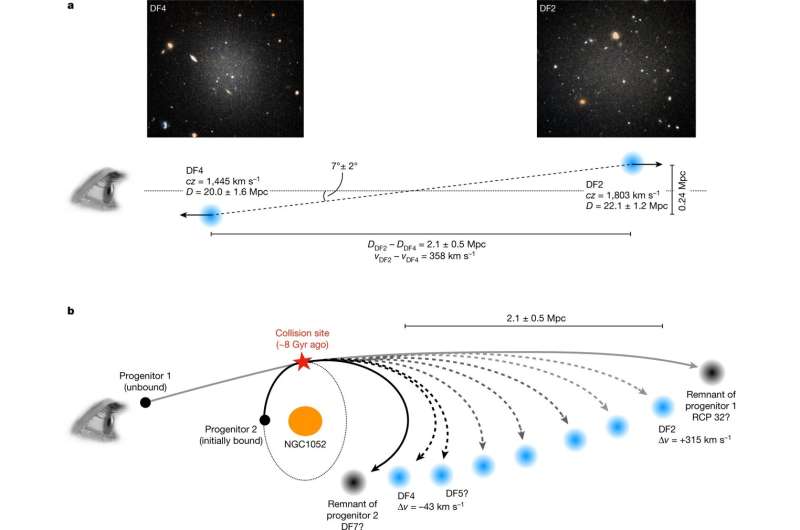Geometry of the DF2 and DF4 system. a, The radial velocity difference between DF2 and DF4 is 358 km s−1 and this large velocity difference is accompanied by a large line-of-sight separation of 2.1 ± 0.5 Mpc. The geometry implies that the galaxies are moving away from each other. Tracing their positions back in time, we infer that they were formed in a high-speed encounter ≥6 Gyr ago. b, Example of a collisional scenario involving NGC 1052. Velocities are given with respect to that galaxy (cz = 1,488 km s−1). An infalling gas-rich galaxy on an unbound orbit collided with a satellite of NGC 1052 about 8 Gyr ago, leading to two dark remnants (possibly RCP 32 and DF7), DF2 and DF4, and three to seven other dark-matter-free galaxies. Credit: Nature (2022). DOI: 10.1038/s41586-022-04665-6
A team of astrophysicists affiliated with multiple institutions in the U.S., one in Germany and one in Canada, has developed a new theory to explain the existence of odd, dark matter–free dwarf galaxies. In their paper published in the journal Nature, the researchers propose that a collision between two dwarf galaxies could explain the dark matter–free dwarf galaxies that have been discovered over the past several years. Eun-jin Shin and Ji-hoon Kim with Seoul National University have published a News & Views piece in the same journal issue, outlining the work and findings by the researchers in this new effort.
In 2018, scientists discovered a dwarf galaxy that appeared to have no dark matter—it had no detectable gravitational pull. Then, in 2019, another team discovered one in the same general vicinity as the first. Since that time, scientists have been seeking to explain the strange findings.
In this new effort, the researchers expanded on studies by other teams indicating evidence of dark and normal matter separating on a large scale when clusters of galaxies collide. The researchers suggest something similar happened to result in two or more dwarf galaxies forming with no apparent dark matter. They note that there are several other dwarf galaxies near the two that have been found already, and they all appear to line up in the sky—evidence, perhaps, of a collision between two dwarf galaxies. They note that the two galaxies studied thus far are moving away from each other, suggesting they may have the same origin.
The researchers suggest a collision between two dwarf galaxies could have split the gas within them , resulting in the formation of new, smaller dwarf galaxies, some with no dark matter. Those without dark matter, the researchers suggest, could have formed because dark matter does not interact with itself or regular matter, meaning it could easily have exited the debris field from the collision, and even continued out into space.
More information: Pieter van Dokkum et al, A trail of dark-matter-free galaxies from a bullet-dwarf collision, Nature (2022). DOI: 10.1038/s41586-022-04665-6
Eun-jin Shin et al, Giant collision created galaxies devoid of dark matter, Nature (2022). DOI: 10.1038/d41586-022-01298-7
Journal information: Nature
© 2022 Science X Network
























